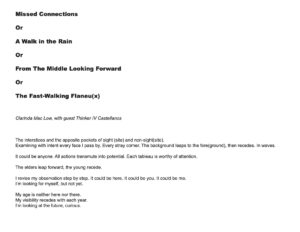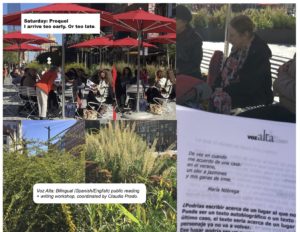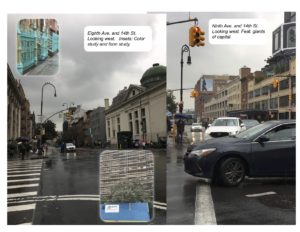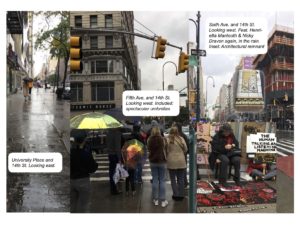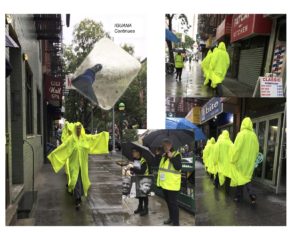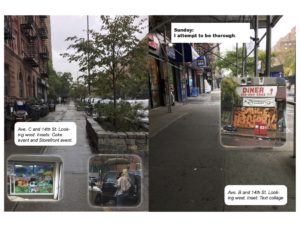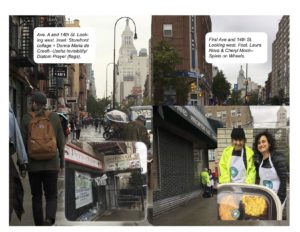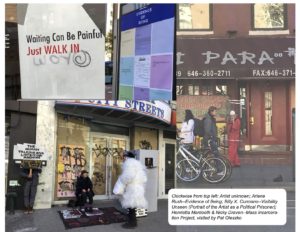Thinkers in Residence spend time on 14th Street over the festival weekend reflecting on 14th Street, patterns of movement, artists, pedestrians, publics, personal reflections, and participation. Their responses take the form of writing, walking, image-making, poetry, or on-the-spot conversations with the public.
And now the observations of Sean Mooney:
2019.10.22
Sean Mooney
Notes on Art in Odd Places
Lucio Pozzi performance, “Beating the Odds”
Saturday, October 18 and Sunday, October 19, 12:00 – 12:32 pm

Lucio Approaching; Sean Mooney
I had the pleasure to reunite with Lucio Pozzi, after not seeing him for perhaps 25 years. In many ways, his participation in this year’s Art in Odd Places festival, my long hiatus since seeing him and other artists taking part, and the poignancy of the many changes that have happened along 14th Street during the intervening years, are merged in my mind into a fused symbolic experience, reflective of the central theme of this year’s festival. The fact that this year’s curator, the artist LuLu LoLo, has chosen to include artists over the age of 60 as her central organizing principle, lent a contemplative quality to the event. Acutely felt were the full lifetimes of labor, thought and experience embodied in this group of artists. There was an uncanny attention to temporal issues: to life’s passage, to the changes one accepts (begrudgingly or otherwise) over time, to transitions of body and environment; and to the deeper contemplation of anxieties and meanings which we, as aging individuals in this very particular location, cannot help but feel and to push back against. Lucio’s performance, in this context, suggested these and may other unstated realities, while doing so in restrained gestures.
The performance itself can be described in simplistic terms as such: the artist drew with several colors of chalk on the sidewalk a series of overlapping shapes that suggested the outlines of human bodies, not unlike the sort of cartoons once considered typical at the scene of a crime. The multi-colored shapes were drawn in a fragmentary fashion: some are clearly human bodies, others are disembodied limbs and heads, or altogether ambiguous. In all, they suggested a flattened-out pile of disorderly figures, as if shadows or ghosts remaining in a battlefield.
Next, the artist put on a white face mask, a Venetian carnival mask which is formed with a long bird’s beak, a skull-like face, and prominent outlines of eyeglasses painted in black. He was otherwise dressed in a dark costume and shoes, and carried a small wooden baseball bat. At the strike of a small brass gong, the artist – now transformed into a shamanic being – began an unstructured dance, in which he incanted an unintelligible, guttural song while occasionally striking towards the drawn figures in a threatening manner with the baseball bat. The shaman pantomimed a violent event, but did so gently, symbolically, his magic bat never hitting the ground, his movements never overt or quick. It was not quite the slow-motion movements of Japanese Noh theater, but close to that tradition in spirit, one in which the silent passages and stillness between gestures and words form the heart of the dance narrative.
Lucio describes this performance as an exercise in ambiguity (this is my paraphrase, not a quotation from Lucio). However, several distinct meanings are suggested throughout this dance: the shaman-dancer is playing a role acted out in many traditional cultures since prehistoric times; a mediator with the spirit world, the mask transforms him both physically and emotionally. I am reminded of the annual Qasgiq dances of the Central Yup’ik people of Alaska; and of the many shamanistic ceremonial dances of the Kwakwaka’wakw (Kwakiutl) peoples of the Pacific Northwest Coast of British Columbia. By contrast, there are the reports of improvised dances at the Cabaret Voltaire in Zürich by the early Dada artists, wearing masks by Marcel Janko. In the case of these Dada performances, which happened during the most brutal days of the Great War being enacted just across the Swiss border, participants responded to the breakdown of European society into chaotic disorder and unprecedented violence, and (what the artists considered) the failures of their hierarchical social traditions. For them, the wearing of masks, the dances with drums and loud instruments, the recitation of nonsensical, invented languages that communicated nothing but grunts and howls, mimicked the frustration with sense and order, and mocked its meaning. They attempted to combat literacy and logic with their own invented chaos and bacchanalian ceremonies, an emotional query that ultimately led them, and their offspring the Surrealists, to explore the spheres of anthropology and the art of indigenous societies.

Kotsuis and Hohhung, ‘Nak’waxda’xw (Noaktok) masked dancers, ca. 1914, British Columbia; photo Edward Curtis
Quite the opposite is true among traditional societies, however. For most indigenous peoples, masked dancing represents the highest social orders, reflected and enacted in ceremony. It suggests communion between the spirit world and the village, between what is known and unknown, between past and future, between life and death. It is the ultimate recognition of ancestral lineage, a distillation of tradition and harmony. Masked dancing is, in the case of the Yup’ik people, Agayuliyararput (“our way of making prayer”).
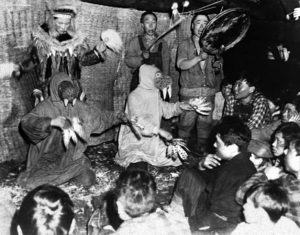
Yup’ik masked dancers performing in the Qasgi house, Qissunaq, Alaska, 1946; photo Alfred Millotte.
Having these thoughts in mind lent meaning to the responses of the unsuspecting passers-by who witnessed Lucio’s masked dance on 14th Street. Most everyone looked confused but seriously at the masked dancer: Was the yielding of the baseball bat threatening? Was the unintelligible song a crazed rant? Some smiled as they passed, or slowed down to watch, stopped to take a photo. Others pretended to ignore it, some gave it a wide berth. The presence of a circle of watchful attendees signaled that this was an organized event, and that the artist was not merely a raving lunatic, but rather an eccentric actor in some sort of play. While Lucio purposely made the staged boundaries of his chalk drawing small enough to allow those passing through to have a clear pathway around him, all who wished to pass respected not only Lucio’s personal space, but also the space occupied by the drawing. Pedestrians stepped into the street rather than cross on top of the drawing. This was significant since it suggests a deep taboo against stepping upon a work of art, which, especially when the images represent human figures, in itself is suggestive of violence. Lucio’s masked shaman, waving a bat at the drawings, as if beating them, reinforced this association. Naturally, most people avoided entering what could understandably be interpreted as a battlefield, a space of repression, albeit one in which no obvious harm was being done to any living being.
While Lucio’s dance suggested violence (including sexual violence, as he interspersed the danced beatings with phallic gestures with the bat), it also suggested the ritual destruction of this place we consider home. Home is always sacred ground. Native Americans almost universally ascribe their lands to be imbued with power and spirit. To name but one example of many, the Central Yup’ik of Alaska use the term Ella to describe this: it is simultaneously the word for the weather, for consciousness, and for all the known and unknown spiritual and physical entities of the universe. Ella is like the Catholic Holy Spirit, all that is seen and unseen, ever present and pervasive. Another Yup’ik term is Yua, which is the personalized human spirit (the soul, to use a Christian analog). But in the Yup’ik concept, Yua is both personal and interchangeable; it may inhabit any living creature, animal, plant, rock or cloud. All entities in the world have the capacity to be embodied with Yua, the “personal human.” Therefore, the Yup’ik relationship to homeland is highly sacred, in that everything around is teeming with ancestors, spirits, continuity and life. And because all animals are possessed with Yua, a human spirit, the hunter approaches prey with respect, since he does not know whether he may encounter the spirit of his own grandfather.
Watching Lucio’s performance I felt this very keenly, and personally. As someone who has lived in New York since being born here in 1967, the immediate vicinity of 14th Street is rife with associations. For me, this place is full of ghosts, sacred and profane. I recall the numerous friends and acquaintances whom I’ve walked with on these sidewalks, many of them now gone. I note how each decade in New York has brought with it strange physical changes, new residents, tourists ( when did they arrive?! and why? ), the destruction and reconstruction of buildings, the ebb and flow of traffic patterns and changing pedestrian habits (why is everyone so slow these days?). Most poignantly, there are those ineffable “feelings” of the street, qualities one cannot describe precisely, but sense, like a brisk wind in a changing season. We always understood which blocks were dangerous, which were safe, where to find solace and where to avoid. It wasn’t that long ago (or was it?) when Union Square Park was boarded up, inaccessible, during an attempt to keep out vagrants and druggies and troublemakers and whatever other misfits the city authorities may have thought deserved a categorization with rats. I sometimes peeked inside that fence late at night to get a glimpse of the trees.
West 14th Street was, up until recently, a “midtown” version of the loosely post-industrial “downtown” of SoHo and Canal Street, where artists traditionally kept studios (in the years I consider “my days” of inhabiting that scene). Marcel Duchamp kept a studio at 210 West 14th Street, from 1942 until 1966, where he made his famous final sculpture, Étant Donnés (Lucio’s performance was enacted directly across the street; a coincidence?). But 14th wasn’t considered the center of the action. It was an off-center, not-quite-there street, as far as the official “art world” was concerned. Even Duchamp was considered “lost” at this “lost” location; at the time, everyone had assumed he had stopped making objects altogether. West 14th Street was a scattering of weird shops and ethnic restaurants. There was the YMCA, an assembly of transients. Nearby was the center for the blind and a string of other residences for recovering people of various ailments. There was usually a scattered parade of homeless passing through. There were a jumble of night clubs which did not advertise their presence and were mostly sub-basement joints, devoid of light or bathrooms or cabaret licenses. I once danced the night away at such a place on 14th Street, alone, with a small handful of strangers and a live band. I don’t believe this club had a name, it was just a place one wandered into and back out of, not quite real, flickering, like life itself, a dream half-remembered.
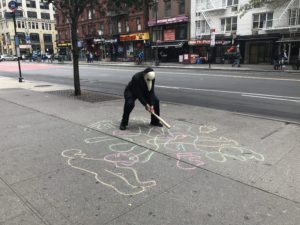
Lucio Attacking; Lorenza Sannai
Lucio, in his trance, bearing a strange white mask and beating against fragmented drawings of human figures on the sidewalk, was acting out a sacred ritual of dispersion, ritually scattering all our ghosts, perhaps also his own. (This white mask is suggestive of an inverted white Raven figure, one of the most divine of all beings in Alaskan tribal mythology: there is a legend in which the Milky Way is defined as “the tracks of White Raven,” made by a spirit who was originally the color of white ivory before being covered in coal dust to teach him humility). Spirits of an unrecorded New York were concentrated below him, overlapping. Our own lives and our own city flew out into immutable space, into ether, into dust, into nonsense, into poetry.
Much of the 14th Street I remember from my youth no longer exists, and many things in this familiar place are strange. Just days before the festival, in fact, cars were permanently banned from driving along 14th Street, to make way for busses, and on this first weekend of this new experiment in urban planning there was an eerie quiet, sucking out an element of the vitality of this once-chaotic street. Not exactly silence, but another layer of oddity in this oddly banal location.
At the end of 32 minutes, the gong was rung again, for 32 beats, and the shaman froze, the performance ended.
Illustrations:
Lucio Pozzi, performing Beating the Odds, October 20, 2019
Yup’ik masked dancers performing in the Qasgi house, Qissunaq, Alaska, 1946; photo Alfred Millotte.
Kotsuis and Hohhung, ‘Nak’waxda’xw (Noaktok) masked dancers, ca. 1914, British Columbia; photo Edward Curtis
